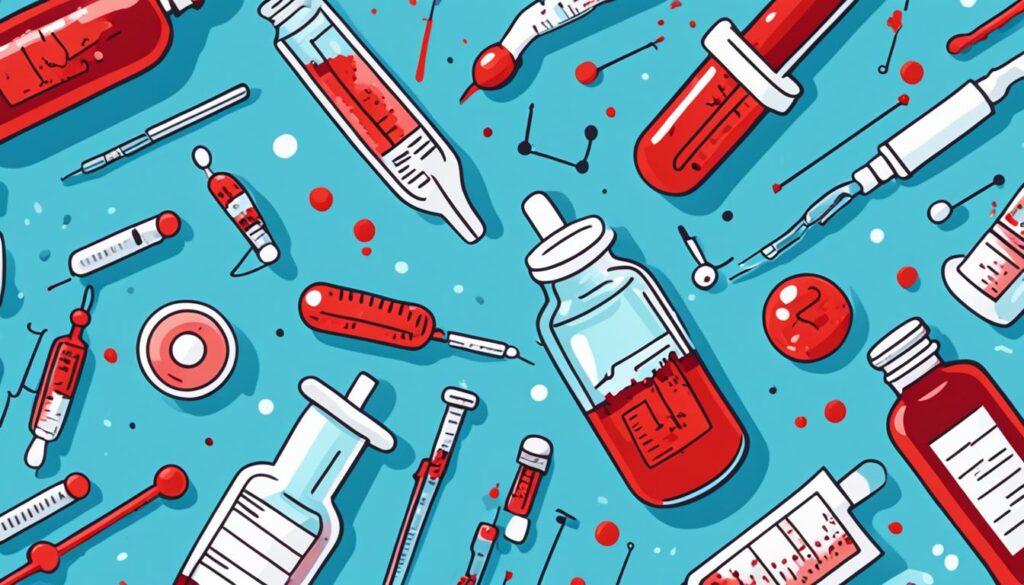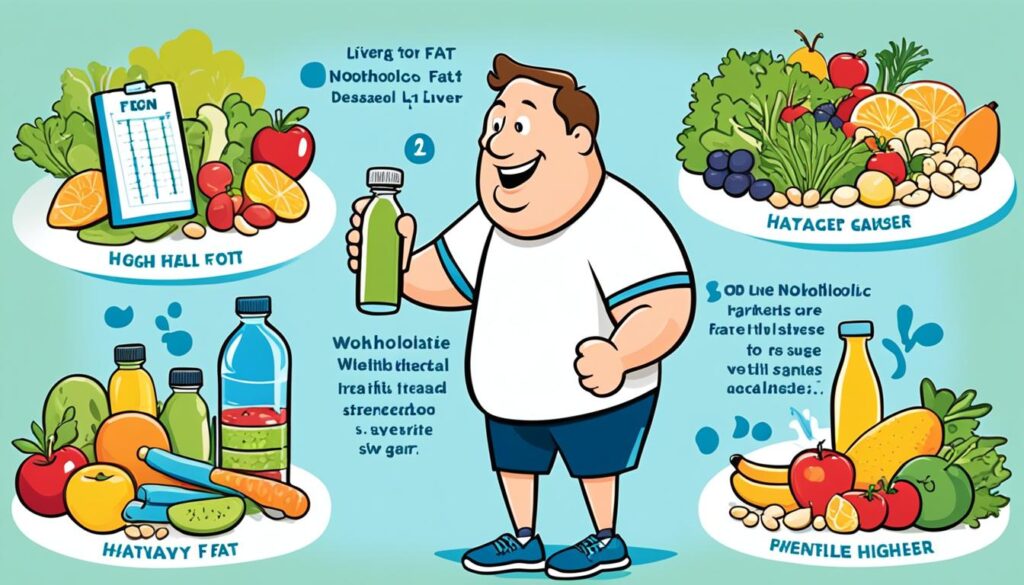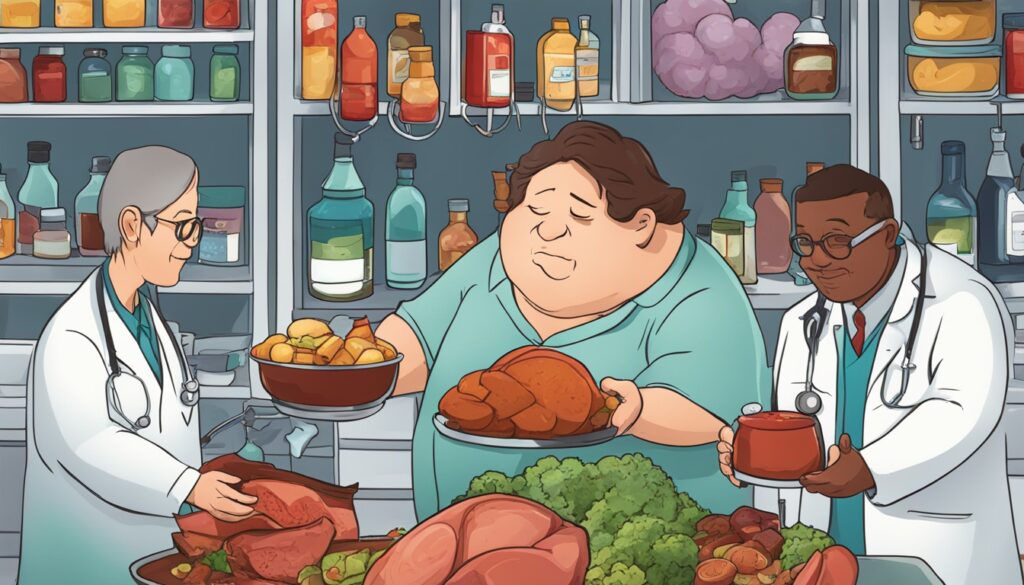|
Getting your Trinity Audio player ready... |
Nonalcoholic fatty liver disease (NAFLD) is a common liver problem worldwide. Lifestyle changes are key for treating it. These include eating healthy, staying active, and losing weight slowly. There’s no specific medicine for NAFLD yet, so personal health choices are important.
Table of Contents
ToggleThis article looks at how to treat NAFLD with both lifestyle and medical approaches. It aims to help improve health by managing NAFLD effectively.
Understanding Nonalcoholic Fatty Liver Disease (NAFLD)
Definition and Prevalence
Non Alcoholic Fatty Liver Disease (NAFLD) happens when the liver has too much fat. It affects over 5% of liver cells. This occurs without drinking too much alcohol or from other liver diseases. NAFLD is common, impacting at least a quarter of American adults. In other places like China, Europe, Japan, and the Middle East, it affects 15-35% of people.
Stages and Progression
NAFLD can grow from simple fat build-up to serious conditions. These include NASH, fibrosis or cirrhosis, and liver cancer. NASH is a severe stage of NAFLD. It involves both inflammation and liver damage, along with the fat in the liver.
Risk Factors
Obesity, type 2 diabetes, and metabolic syndrome are main risk factors for NAFLD. So are poor diet and not being active. NAFLD doesn’t often show symptoms, making it hard to detect without tests.
Diagnosis of NAFLD
Diagnosing nonalcoholic fatty liver disease (NAFLD) involves looking at your medical history and giving you a physical exam. It also includes several tests. NAFLD usually has no clear Nonalcoholic Fatty Liver Disease Symptoms. So, often it’s found by accident in regular blood tests or medical pictures.
Blood Tests
One key step in finding NAFLD is a blood test. A complete blood count, liver enzymes, and liver function tests may be done. This shows how healthy your liver is. The tests can catch fat in the liver and any harm or inflammation.
Your doctor might also do a lipid profile. This checks your cholesterol and triglycerides. These can be high in NAFLD.
Imaging Procedures
Imaging tests are vital for diagnosing NAFLD. Your health provider might suggest:
- Abdominal ultrasound: Sound waves are used to see your liver. They can spot extra fat.
- MRI (magnetic resonance imaging): This gives detailed liver info with magnetic waves.
- CT (computed tomography) scanning: These scans can show liver fat too.
Liver Biopsy
Sometimes, you may need a liver biopsy. This test is to be sure of NAFLD and see how bad the liver is hurt. It takes a small liver piece to look at under a microscope. A biopsy is the best way to diagnose NAFLD and tell if it’s NAFL or NASH.

Lifestyle Modifications for NAFLD
Changing how you live is key to dealing with NAFLD. You can boost your liver’s health and your general fitness by tweaking your weight, food intake, and how active you are.
Weight Loss and Healthy Diet
Even shedding 3-5% of your body weight helps with NAFLD. But aiming to drop 10% or more is often better. Eat plenty of fruits, veggies, and whole grains. And cut down on foods high in saturated fats and sugars. The Mediterranean diet is a good pick. It’s about eating healthy fats, lean meats, and carbohydrates that are good for you.
Regular Physical Activity
Moving more can get your liver in better shape if you have NAFLD. Try mixing up your workouts with cardio and strength training. This means brisk walks or swims, and things like lifting weights or doing squats. Even just a little more exercise can really help with NAFLD.
Managing Comorbidities
NAFLD often comes along with other health issues like diabetes or high cholesterol. It’s important to treat these too. Your health team can put together a plan that’s just for you. It will help make sure all your health needs are met.

Medical Interventions for NAFLD
Lifestyle changes are key for treating NAFLD. But, some patients may benefit from medical help too. A new drug, resmetirom (Rezdiffra), treats NASH and severe liver damage by reducing fat and improving health & Reversing Liver Damage From Fatty Liver
Severe NAFLD cases leading to cirrhosis might need a liver transplant. Yet, managing NAFLD mainly focuses on changing your lifestyle. A good Diet For Nonalcoholic Fatty Liver Disease, exercise, and slowly shedding weight can help a lot without many medical treatments.

Deciding the best way to treat your NAFLD involves your doctor. They look at the disease’s stage, any other health issues, and what might work best for you. Working with your doctor is crucial for the best results in treating this liver problem.
Role of Vitamin E and Antioxidants
Studies show that vitamin E supplements might help some people with NAFLD, especially those without type 2 diabetes. Vitamin E can lower liver inflammation and oxidative stress. These are important in the start and growth of NAFLD.
Many research papers have looked at what vitamin E does for NAFLD. One study in mice suggested it could stop NASH, a severe form of liver disease. It seems that antioxidants, including vitamin E, can help prevent NASH in mice.
Clinical research also supports vitamin E’s role in NAFLD management. A study in 2000 by Lavine saw improvement in children with nonalcoholic steatohepatitis. Another in 2004 by Kawanaka found that vitamin E cuts down oxidative stress and certain markers in people with NAFLD.
But, we still need more research to be sure about vitamin E’s benefits and safety for NAFLD. If you’re thinking about taking supplements, talk to your doctor first. They can help figure out if it’s the right choice for you.

nonalcoholic fatty liver disease treatment
Managing nonalcoholic fatty liver disease (NAFLD) means using a mix of methods. This includes approved medications and new treatments. Lifestyle changes are key, but medicines can also help in complex cases.
Approved Medications
Resmetirom (Rezdiffra) is the FDA’s only approved drug for NAFLD. It cuts down liver fat in people with NASH and severe scarring. It works on certain body pathways to boost liver health.
Emerging Therapies
There aren’t many FDA-approved drugs for NAFLD yet. But, scientists are looking into more medicines. These new treatments target different parts of the disease, like lowering swelling and bettering how insulin works. They also seek to heal liver fiber. Although no more drugs are currently greenlighted for long-term NAFLD care, we’re making progress. New treatments might pop up as we learn more about this disease.
Managing Complications of Advanced NAFLD
As NAFLD gets worse, patients might develop serious issues, especially if it turns into liver cirrhosis. These problems could be portal hypertension, liver failure, or even liver cancer. For some, a liver transplant might be their only hope.
Liver Cirrhosis
People with NAFLD that leads to cirrhosis are more likely to face severe liver disease issues. One of these is portal hypertension, which can cause esophagus veins to swell, posing a bleeding risk. They could also face liver failure, as a badly damaged liver can’t function well.
Having cirrhosis from NAFLD also raises their chance of getting hepatocellular carcinoma, a type of liver cancer.
Liver Transplantation
If NAFLD causes severe, irreversible liver damage, a transplant might be the best choice left. During a transplant, a healthy liver from a donor takes the place of the patient’s failing liver. This surgery is life-saving but involves high risks and must be carefully managed by a team of experts.
Even though NAFLD’s advanced stages can be very serious, the main treatment focus still lies in lifestyle changes and sometimes, medicine. This approach aims to stop the disease’s advance, preventing the need for a transplant. By working together, doctors and patients can reduce NAFLD’s harm, a key health issue worldwide.
Integrative Approach to NAFLD Management
To handle nonalcoholic fatty liver disease (NAFLD) well, many healthcare workers must join forces. This includes liver specialists, family doctors, nutrition experts, and fitness professionals. Their team approach lets each patient get treatment that fits them, along with the support they need.
Collaboration Between Healthcare Providers
Experts from various fields should unite to look after NAFLD patients thoroughly. Hepatologists are skilled at spotting and controlling liver issues in the disease. Meanwhile, family doctors focus on managing other health problems and coordinating care. Dietitians and fitness trainers help by designing lifestyle plans that meet the patient’s specific needs and likes.
Patient Education and Support
As healthcare workers team up, helping patients learn and stay focused is key. People with NAFLD must know what it is, its dangers, and why they need to live healthily. This means eating well, moving often, and losing weight slowly. The healthcare team should help them set reachable health goals, share info, and cheer them on.
Prevention Strategies for NAFLD
Preventing NAFLD is critical as it can cause severe liver issues. It’s important to act both on our own and together. This approach helps everyone fight NAFLD, keeping our communities healthier.
Public Health Initiatives
Efforts in public health can make a big difference. They focus on eating better and moving more to prevent NAFLD. Working with schools, local groups, and more can change many lives for the better.
Lifestyle Counseling
Doctors and nurses help a lot by talking to their patients about healthy living. They show how eating well and exercising can keep people safe from NAFLD. Tips like eating the right portions and moving often are key here.
We need to use all tools to stop NAFLD. This means both community-wide work and one-on-one advice. By doing this, we can drop NAFLD rates and boost our community’s health.
Ongoing Research and Future Directions
Researchers are finding new ways to study nonalcoholic fatty liver disease. They’re looking at new medicines and how digital health tools can help. They want to understand the genes and environment factors affecting the disease’s growth.
Digital tools like mobile apps and wearables are getting attention. They’re helping patients make healthy changes. This includes keeping track of what they eat, how active they are, and their weight. The idea is to provide tailored advice and keep people motivated to stick to healthy habits.
Scientists are also diving into how NAFLD works. They’re studying things like insulin resistance, fat toxicity, and imbalanced gut bacteria. Their goal is to find new drug targets and more specific treatments.
There’s a push to make diagnosing NAFLD easier and less invasive. New imaging methods and biomarkers could mean fewer liver biopsies. This would help spot the disease earlier and track it better.
The hope is that with ongoing research, we’ll find better ways to treat NAFLD. These new approaches could really improve the lives of those with the disease.
Conclusion
Nonalcoholic fatty liver disease (NAFLD) is a major health issue that needs hard work from different angles to manage. Currently, there are no medicines specifically for treating it. However, focusing on losing weight, eating healthily, and being active are key. Such lifestyle changes are the main way to care for NAFLD.
Healthcare teams and NAFLD patients should team up. Together, they can create customized plans. These plans will help patients make lasting, healthy lifestyle changes. As science progresses, we may see new ways to fight NAFLD. This could provide more options for managing this health concern.
The bottom line with nonalcoholic fatty liver disease is that lifestyle changes are vital for treatment. While we await new medical solutions, working with your healthcare team is crucial. They will guide you in making changes that benefit your health. Ultimately, taking an active approach can help manage NAFLD and boost your health overall.
FAQ
What is nonalcoholic fatty liver disease (NAFLD)?
Nonalcoholic fatty liver disease (NAFLD) happens when your liver stores too much fat. This affects more than 5% of your liver cells. It’s not caused by drinking too much alcohol or other liver problems.
What are the risk factors for NAFLD?
Risk factors for NAFLD are being obese, having type 2 diabetes, or a metabolic syndrome, and leading an unhealthy life. This life includes eating poorly and not moving much.
How is NAFLD diagnosed?
Doctors diagnose NAFLD using blood tests to check liver enzymes. They also use pictures of your stomach with ultrasound, MRI, and CT scans. The best way to check is a liver biopsy.
What are the recommended lifestyle modifications for managing NAFLD?
To manage NAFLD, doctors recommend losing weight. They also advise eating a healthy diet full of fruits, veggies, and whole grains. Doing regular aerobic and resistance exercises is also key.
Are there any approved medications for NAFLD treatment?
The FDA has only approved one drug, resmetirom (Rezdiffra), for treating NAFLD. It can reduce fat in the liver for those with NASH and severe scarring.
Can supplements like vitamin E be beneficial for NAFLD?
While some studies show vitamin E might help NAFLD without diabetes, more research is needed. This vitamin could reduce liver inflammation and stress. But it’s not certain if it’s truly effective or safe alone or with other antioxidants.
What are the potential complications of advanced NAFLD?
If NAFLD becomes severe, it may lead to liver cirrhosis. This can cause problems like high blood pressure in your liver, liver failure, and liver cancer.
How can healthcare providers support NAFLD management?
Taking care of NAFLD needs a team effort from different health experts like liver doctors, general doctors, dietitians, and fitness trainers. Teaching and supporting patients is also very important for them to make healthy changes and stick to their treatments.
What are some public health initiatives for NAFLD prevention?
Big public health efforts, like teaching better nutrition and making it easier to be active, can really help stop NAFLD from affecting large numbers of people.
What are the future directions in NAFLD research and treatment?
The future of NAFLD research and treatment includes looking at new drugs, using digital health tools to change lifestyles, and better understanding the genetic and environmental roots of the disease.
Source Links
- https://www.mayoclinic.org/diseases-conditions/nonalcoholic-fatty-liver-disease/diagnosis-treatment/drc-20354573
- https://www.ncbi.nlm.nih.gov/pmc/articles/PMC3002502/
- https://www.niddk.nih.gov/health-information/liver-disease/nafld-nash
- https://www.mayoclinic.org/diseases-conditions/nonalcoholic-fatty-liver-disease/symptoms-causes/syc-20354567
- https://www.hopkinsmedicine.org/health/conditions-and-diseases/nonalcoholic-fatty-liver-disease
- https://www.ncbi.nlm.nih.gov/pmc/articles/PMC7005657/


